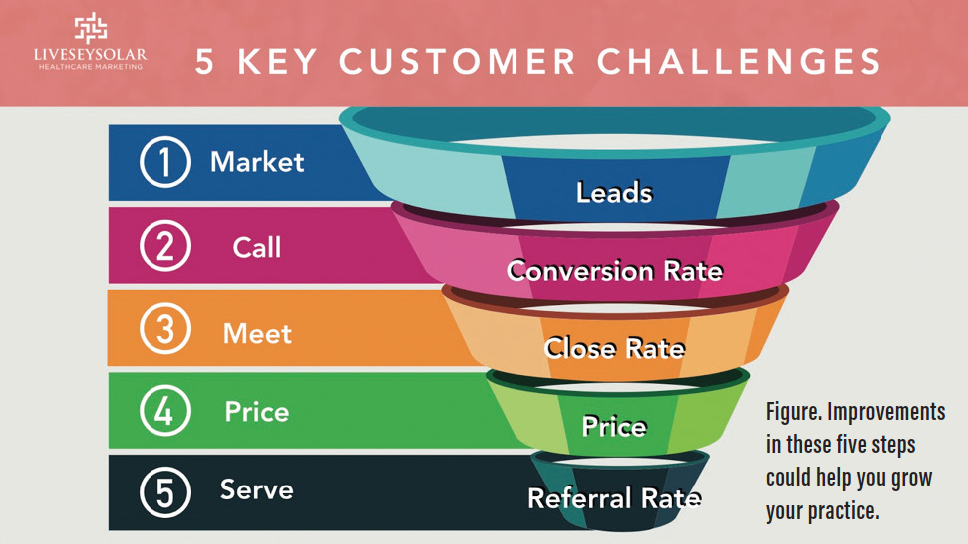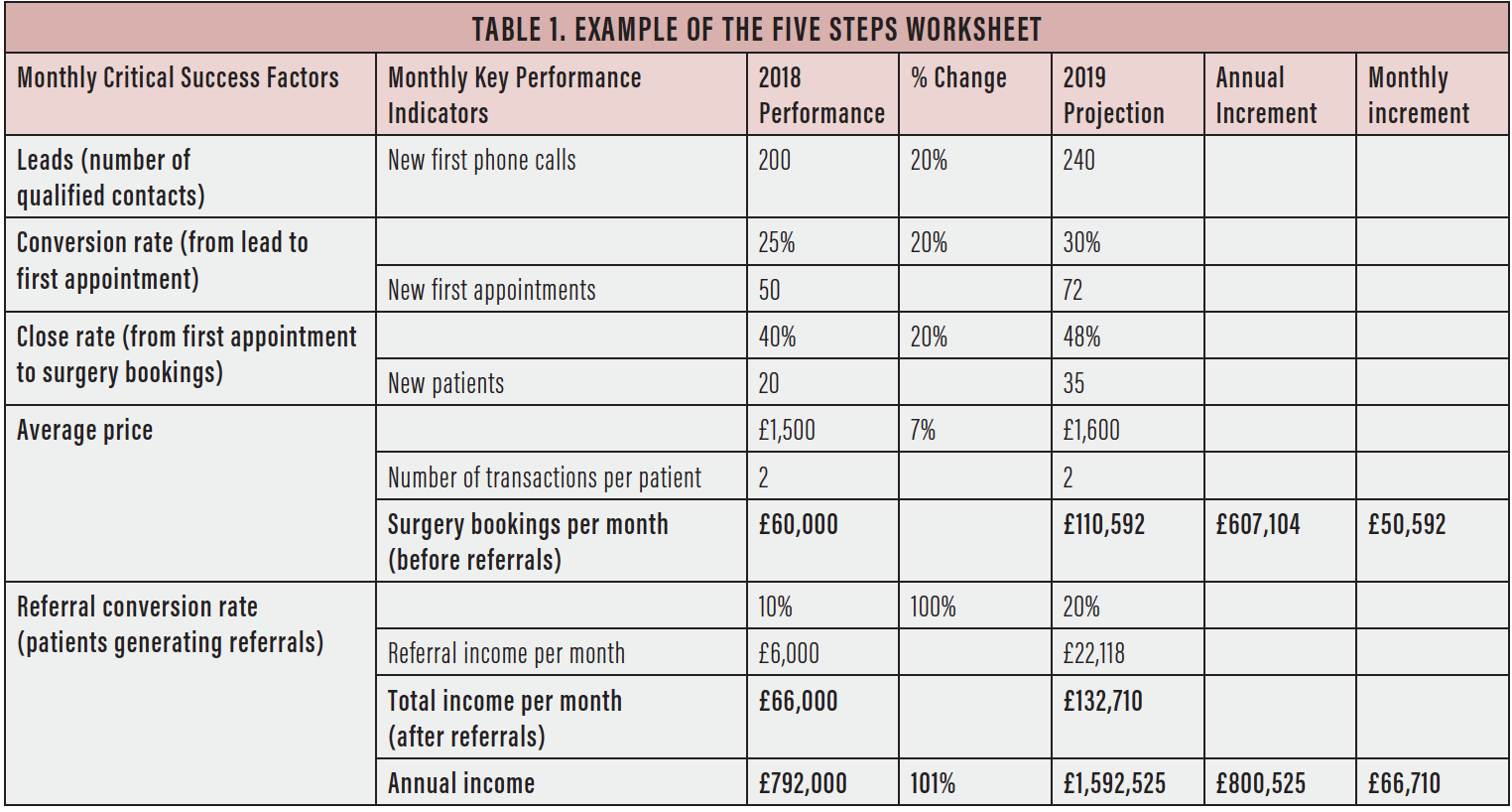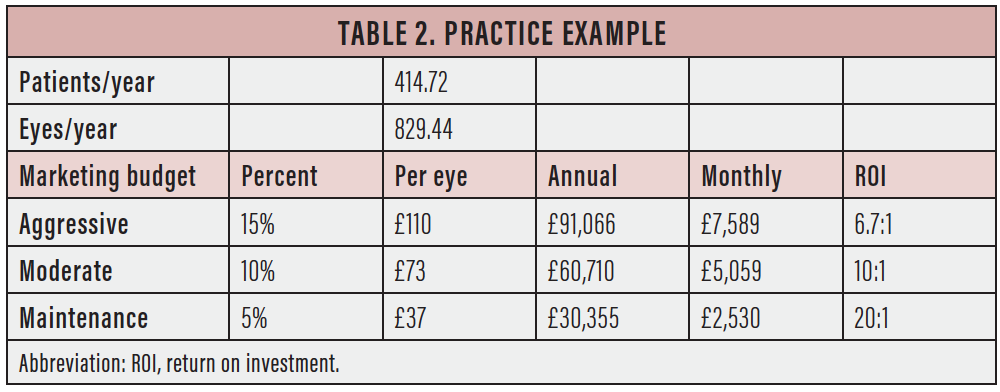

Most health care practices today will not experience any growth over the next 1, 3, or 5 years because most practices operate on a day-to-day basis. They are not actively moving toward new and exciting futures. But your practice could be different.
You could watch as your practice expands and transforms before your eyes by implementing a new step every 90 days. You could see your key performance indicators, income, patient relationships, clinical efficiency, and job satisfaction all improve. In this article, we will help you lay the groundwork to grow your refractive cataract surgery practice.
OUTLINE A STRATEGY
There are five steps you should take to double the size of your practice this year (Figure):
- Step No. 1: Increase leads;
- Step No. 2: Increase first-call conversion rates;
- Step No. 3: Increase first-appointment close rates;
- Step No. 4: Increase average price; and
- Step No. 5: Increase rate of referrals per patient.

Figure. Improvements in these five steps could help you grow your practice.
At the start of 2019, you should complete the exercise in Table 1 for your own practice. In the 2018 column, enter your average monthly figures for each of the boxes. In the 2019 column, enter average monthly figures that you think will be realistic goals.
Table 1 shows an example from a practice with realistic 2018 and 2019 numbers. Note that, even though this practice makes only relatively small improvements in the five factors, it can still double its revenues.
The practice in Table 1 used the following steps:
- Step No. 1: Increase leads by 20%, from 200 to 240 per month;
- Step No. 2: Increase first-call conversion rates by 20%, from 25% to 30% per month;
- Step No. 3: Increase first-appointment close rates by 20%, from 40% to 48% per month;
- Step No. 4: Increase average price by 6.67%, or £100 per eye (from £1,500 to £1,600); and
- Step No. 5: Increase rate of referrals per patient from 10% to 20%.


FIRST QUARTER OF 2019: GAIN MORE LEADS
When you feel you are not getting enough interest and attention from your target market, you need leads. Therefore, start with Step No. 1. Do everything in your power to increase leads by 20% over the course of the year, starting in January. You can increase your leads by optimizing your audience targeting, marketing messaging, and promotional offers.
How much you spend on lead generation depends on how much you want to earn and how smart you are with optimization. In our experience, successful refractive surgeons spend between £150 and £300 per eye in marketing costs to acquire one laser eye surgery patient. Whether you are on the low or high end of that range depends on several factors:
- Your goals;
- How long you’ve been in practice;
- Where you practice;
- How much digital versus traditional marketing you do;
- Your first-call conversion rate;
- Your first-appointment conversion rate;
- Your prices; and
- Your competitive environment
For example, if you want to treat 415 patients (35 patients each month for 12 months), you might need to invest £1,600 per eye in marketing costs to earn a total of about £1,600,000 in 2019, like our hypothetical practice example (Table 2). If you wish to increase your revenue by £607,000 (the incremental difference), we advise you to spend between £30,000 and £90,000 on marketing.

This marketing budget equals between 5% and 15% of total revenue. The higher figure would not surprise us in an aggressive scenario (for example, doubling a business). Somewhere in the middle (10%, for example) would be appropriate if you wish to take a moderate path. The lower end of the spectrum, 5%, makes sense if you are either very well positioned or seeking to maintain your current level of volume.
The less you spend, the higher your return on investment will be. Of course, the less you spend, you also increase the risk that your investment will not achieve your desired result. Spending more on marketing increases your likelihood of reaching your growth objectives, but it also carries the risk that your profits will be lower than you expect. To help mitigate risks, it is crucial to evaluate marketing activities, by calculating how many leads they generate, on a monthly basis.
The percentage of revenue you spend on marketing will be higher or lower depending on your status in the market. If yours is a new practice, you will likely spend more per eye. If you are well established, you may spend less per eye. If you operate in an urban center, you should expect to spend more to acquire patients than you might in a rural area. Usually, the bigger the market, the more competitive it is.
If you rely on traditional offline marketing, expect a lower return on investment. Digital marketing is not only more effective but significantly more measurable, and the cost per lead is much lower.
Referring back to our five steps, you can dramatically lower your marketing cost per eye with better conversion rates on the first call (Step No. 2) and better close rates at the first appointment (Step No. 3). You can afford to spend more on generating leads if you charge sufficiently high prices (Step No. 4) to provide a healthy gross margin. You can further reduce your marketing cost per eye if a higher percentage of your leads arises from referrals (Step No. 5).

SECOND QUARTER OF 2019: IMPROVE CONVERSION RATES
When should you train your staff to increase your first-call conversion rates? If your first-call conversion rate is 50% or less, you could likely benefit from providing telephone training for your staff members. The lower the rate, the sooner you should proceed to Step No. 2. The sooner you improve your first-call conversion rates, the less you will need to spend on marketing per patient. We recommend that you start the training initiative in March, after the winter season winds down. If you do, you should start to see results in April.
When should you train your staff to increase your close rate at the first appointment? If your close rate is 60% or less, then you should earnestly look at first-appointment training. Again, the lower the rate, the sooner you should proceed to Step No. 3. The sooner you improve your first-appointment close rates, the less you will need to spend on marketing per patient. We recommend that you start your training initiative in April. If you do, you should start to see results in June.

THIRD QUARTER OF 2019: RAISE YOUR PRICING
We advise you to evaluate your pricing as soon as possible (Step No. 4), but you may have to wait to launch a price increase until the third quarter of the year. If you currently underprice with regard to the value you provide your patients, you should waste no time in updating your prices. When you are ready, raising prices will more easily enable you to fund lead generation, phone training, and customer service improvements. All of this will make the amount you spend on marketing more efficient. Assuming your team adjusts to their new training and communicates your value effectively, you can likely raise your prices in July.

FOURTH QUARTER OF 2019: IMPROVE CUSTOMER SERVICE
To justify any price increase, you should first improve your customer service (Step No. 5) and conversion effectiveness (Steps No. 2 and 3).
When you address your telephone and consultation conversion rates, you will also get a bonus side effect: Your customer service will improve. Once your customer service efforts improve and you have raised your fees, you need to optimize your customer service before asking patients for reviews and referrals. The more referrals you receive, the less you will pay for each patient, on average, in marketing expenses. You should focus on customer service improvements starting in September.
CONCLUSION
Typically, we advise clinics to take each of the five steps in order. As they proceed, they may find that, as they solve one problem, another develops. For example, the more leads you acquire, the more your team will have to be ready to convert those leads. Often, conversion rates on the first call may suffer. After refining your first-call conversion rate, you may find that your first-appointment close rate begins to decrease under the strain of so many new first consultations. Also, as you raise your fees, you will likely see that your customers become more demanding, which requires you to swiftly improve your customer service.
We hope that this article has provided a starting point from which to double your practice. If you would like more help on how to take the necessary steps to grow, we suggest that you download our free ebook, How to Grow Your Practice With Presbyopic Patients,1 at liveseysolar.com/grow-practice-presbyopic-patients-lp/
As a start, we encourage you to try to implement a minimum of one of the steps described herein. If you need assistance, a practice development consultant can help you assess your needs and prescribe appropriate steps to grow your refractive cataract surgery practice.
1. Solar R, Livesey L. How to Grow Your Practice With Presbyopic Patients [ebook]. London: LiveseySolar; 2018.





